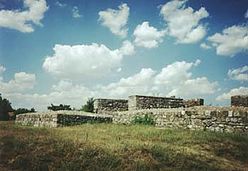Sucidava
| Castra Sucidava | |
|---|---|

Ruins of Sucidava, modern Romania
|
|
| Known also as | Castra of Celeiu |
| Abandoned | 6th century |
| Attested by | Tabula Peutingeriana |
| Previous fortification | Dacian |
| Province | Dacia |
| Administrative unit | Dacia Malvensis |
| Nearby water | Danubius |
| — Stone structure — | |
| Coordinates | 43°45′52″N 24°27′33″E / 43.7644°N 24.4591°ECoordinates: 43°45′52″N 24°27′33″E / 43.7644°N 24.4591°E |
| Altitude | c. 37 m |
| Place name | Cartier Celei |
| Town | Corabia |
| County | Olt |
| Country |
|
| RO-LMI | OT-I-s-A-08492 |
| Recognition |
|
| Condition | Ruined |
| Excavation dates | 1900 |
| Archaeologists | Pamfil Polonic |
Sucidava (Sykibid after Procopius, Σucidava after Pârvan, where Σ is pronounced "sh") is a Dacian and Daco-Roman historical site, situated in Corabia, Romania, on the north bank of the Danube. The first Christian Basilica established in Romania can be found there and the foot of a Roman bridge over the Danube built by Constantine the Great to link Sucidava with Oescus (today in Bulgaria, in Moesia). There is also a secret underground fountain which flows under the walls of the town to a water spring situated outside.
From an archaeological point of view, the coins found at Sucidava show an uninterrupted series from Aurelian (270-275) to Theodosius II (408-450). The archaeological evidence show that in AD 443 or 447 the city was sacked by the Huns, and was restored under Justin I 518-527 or Justinian I 527-565. Around 600, it seems that the Roman garrison abandoned the city.
...
Wikipedia

